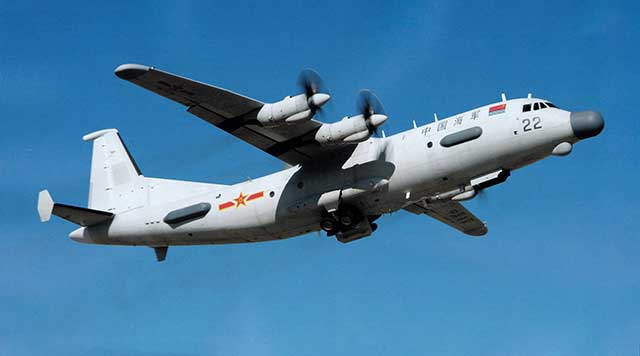On July 17, the Chinese People’s Liberation Army Air Force [PLAAF] deployed nearly 60 aircraft, while the People’s Liberation Army Navy [PLAN] sent 10 ships, all tasked with gathering intelligence on the tactics of the Taiwanese military, which is currently conducting the Han Kuang 41 exercise.

According to an official statement from Taiwan’s Ministry of National Defense, the flights and ship movements were detected at 6 a.m. “Of the 58 flights, 45 crossed the median line and entered Taiwan’s northern, central, southwestern, and eastern Air Defense Identification Zones [ADIZ]. We are monitoring the situation and responding,” the ministry announced.
Hours earlier, another Chinese reconnaissance aircraft, identified as a Y-8, was spotted flying at 5,000 meters near the remote Dongsha Island. “On the evening of July 16 at 7:13 p.m., Taiwan’s Air Force detected a Chinese military aircraft, rarely seen approaching the airspace of the Dongsha Islands in the southwestern air sector at an altitude of 5,000 meters, posing a serious provocation to Taiwan’s national security,” reported Taiwanese media outlet def.ltn.com.tw, part of Liberty Times Net.
Chinese military maneuvers around Taiwan have become routine, keeping the region on edge. Beijing deploys aircraft and ships almost daily to probe the island’s defenses, with the frequency and scale of these operations steadily increasing.
Since 2022, China has intensified its pressure, regularly sending fleets of fighters, bombers, and reconnaissance aircraft. In October 2024, a record 153 aircraft were observed during China’s “Joint Sword-2024B” exercise, and just a month later, on November 29, 41 aircraft again crossed the Taiwan Strait’s median line.
These incidents are not isolated—throughout 2023 and 2024, Taiwanese authorities regularly reported groups of 20 to 60 aircraft intruding into the island’s ADIZ in a single day.
China’s actions during Taiwan’s Han Kuang exercises are particularly notable. In July 2023, Beijing deployed 37 aircraft and seven ships in a single day to test Taipei’s responses. Similar maneuvers occur annually, with China exploiting these moments to gather intelligence and exert psychological pressure.
Less frequent but equally concerning are flights over remote territories like the Dongsha Islands. The reconnaissance aircraft spotted near Dongsha on July 16 echoes a similar incident in 2020.
Taiwan’s Han Kuang 41 exercise, its most ambitious to date, reflects growing fears of Chinese aggression. Running from July 9 to July 18, the exercise is designed to simulate real-world conflict scenarios, focusing on defense against amphibious landings, airstrikes, cyberattacks, and China’s “gray zone” tactics. It includes scenarios for a full-scale invasion, with a particular emphasis on 2027, tied to significant strategic milestones for China, such as the 100th anniversary of the People’s Liberation Army and Xi Jinping’s potential fourth term.
Han Kuang 41 confronts the island with a full spectrum of threats that could arise in a conflict with China. Conducted on an unprecedented scale, it simulates the defense of key ports and beaches against amphibious assaults, reflecting the real danger of a Chinese invasion.
Air attacks were also a focal point, with Taiwanese forces practicing the dispersal of military assets and the use of air defense systems to reduce vulnerability. The exercise included simulations of cyberattacks and disinformation campaigns that could destabilize the island, emphasizing the protection of critical infrastructure and countering psychological operations.
China’s gray-zone provocations, such as actions by its coast guard and maritime militia, were recreated to test responses to tensions short of open war. Preparations for a potential full-scale invasion in 2027, linked to Beijing’s strategic timelines, underscored Taiwan’s long-term view of the threats. Decentralized command structures were also tested to ensure effectiveness even under disrupted communications in combat conditions.
With a scale surpassing all previous exercises, Han Kuang 41 mobilized over 22,000 reservists—a record number compared to Taiwan’s active military of about 150,000, while China boasts two million active troops. The exercise covered the entire island, including the remote Penghu, Kinmen, and Matsu islands.
Advanced weaponry, such as Lockheed Martin’s HIMARS rocket systems and Taiwan’s Tien Chien II air defense missiles, along with indigenous anti-ship and ground-strike systems, were utilized, showcasing Taiwan’s commitment to defense modernization.
The international community has not remained indifferent to China’s provocations during Taiwan’s military exercise. The United States, a long-standing supporter of Taiwan as a key ally, responded swiftly and decisively. On July 5, 2025, according to the Taipei Times, the U.S. State Department condemned China’s military maneuvers as “illegitimate,” stating that they “will increase tensions and are irresponsible.” “China must avoid actions that undermine peace and stability in the Taiwan Strait and the broader region,” the statement said.
The U.S. reaffirmed its commitment to supporting Taiwan against Beijing’s military, economic, and diplomatic pressure, emphasizing its stance against unilateral changes to the status quo through force or coercion. This response reflects Washington’s long-standing policy of defending Taiwan, particularly amid rising tensions in the Indo-Pacific region.
Japan, located in close proximity to Taiwan and heavily reliant on regional security, expressed even greater concern. In its annual defense report, published on July 15, 2025, and cited by POLITICO, Japan’s Ministry of Defense described China’s rapidly increasing military activity as “the greatest strategic challenge.”
The report noted that over the past three years, the frequency of Chinese naval transits near Japan’s southwestern coast has tripled, with sightings of two Chinese aircraft carriers operating together in the Pacific in June and long-range flights by Chinese bombers highlighting the growing threat. “The international community faces a new era of crisis, confronting the greatest challenges since the end of World War II,” the report stated, emphasizing tensions around Taiwan and growing China-Russia cooperation.
While the European Union has not issued a specific statement regarding China’s actions during Han Kuang 41, previous positions indicate a concern for stability in the Taiwan Strait. In April 2023, according to POLITICO, the European Commission expressed alarm over China’s intensified military maneuvers, noting that “any instability in the strait resulting from escalation, incidents, or use of force would have immense economic and security consequences for the region and the world.”
This stance suggests that the EU continues to monitor the situation closely, though with less direct involvement compared to the U.S. and Japan. In March 2025, according to Euronews, G7 diplomats, including European nations, condemned China’s “unlawful, provocative, coercive, and dangerous actions” in the region, indicating that Europe shares broader concerns about Beijing’s actions, though without specific focus on the current exercise.
Other countries, such as Australia, have also expressed concern about China’s growing military activity in the region, though no specific statements directly tied to Han Kuang 41 have been reported. According to Reuters on July 13, 2025, Australian Defense Minister Pat Conroy noted that Australia would not commit in advance to sending troops in the event of a conflict around Taiwan, emphasizing that such decisions would be made by the government at the time of a crisis.
These international reactions highlight the delicate balance that global powers are striving to maintain in the Taiwan Strait. While the U.S. and Japan clearly express support for Taiwan and condemn China’s actions, they carefully avoid steps that could lead to direct escalation. The broader international community, including Europe, appears to favor a diplomatic approach focused on preserving peace and stability while closely monitoring developments.
***
Follow us everywhere and at any time. BulgarianMilitary.com has responsive design and you can open the page from any computer, mobile devices or web browsers. For more up-to-date news, follow our Google News, YouTube, Reddit, LinkedIn, and Twitter pages. Our standards: Manifesto & ethical principles.
How we confirmed this story:
- BulgarianMilitary.com cross-references open-source intelligence, including battlefield maps and geolocated footage, to confirm military movements and resource claims. We analyze official statements, expert insights from defense analysts, and economic data to ensure accuracy.
- Social media posts are scrutinized and validated against primary sources, such as government reports and on-the-ground accounts. Our rigorous process guarantees reliable, fact-based reporting.

